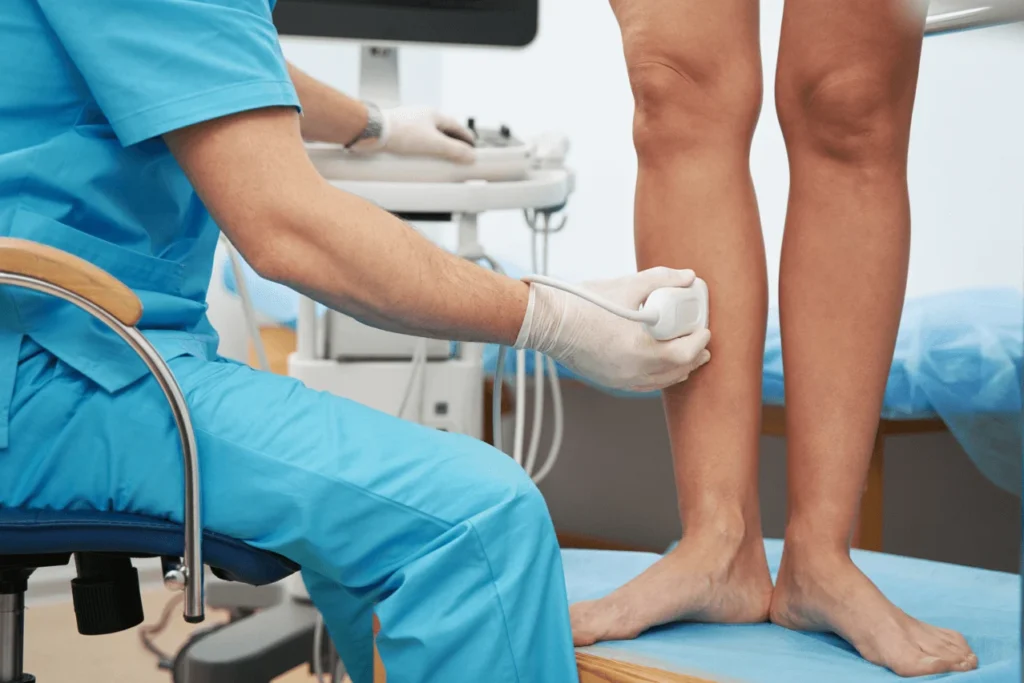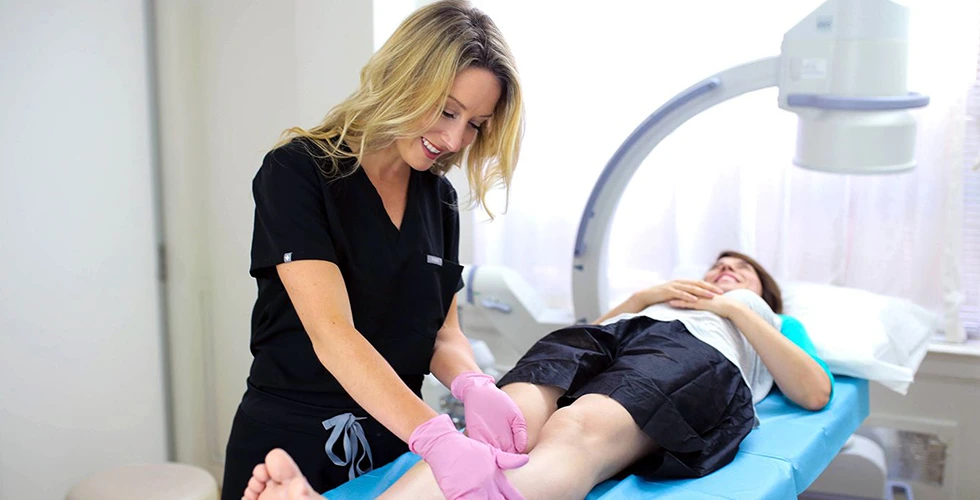What happens during vein ablation?
If you’re asking about vein ablation, also known as endovenous ablation, you probably have varicose veins or underlying chronic venous insufficiency. Varicose veins are dense masses of blood vessels that protrude from the skin’s surface, looking like a thick mass of twisted, tangled, and knotted ropes. They might be greenish, bluish, reddish, or skin-colored, and they usually appear on the lower extremities of the body. Varicose veins are usually caused by chronic venous insufficiency, a circulatory disorder that leads to the accumulation of blood in leg veins because of malfunctioning vein valves.
Endovenous ablation is a group of minimally invasive procedures for patients with varicose veins and underlying vein disease. There are two types of vein ablation procedures: radiofrequency and laser ablation. Both types of vein ablation work on the same principles, but the specific details of the procedure are slightly different.
During endovenous ablation, the vein doctor administers local anesthesia and makes a small incision on the skin’s surface. The incision serves as an entry point for a catheter or a laser fiber driven into the diseased saphenous vein under ultrasound guidance. Once the catheter or laser fiber is lodged inside the diseased vein, the doctor delivers tumescent anesthesia to protect the surrounding tissues and minimize discomfort. When activated, the catheter generates thermal energy, and the laser fiber generates laser energy and immediately destroys the diseased saphenous vein.
Once the diseased vein is neutralized, the accumulated blood reroutes into healthier leg veins, restoring optimal blood circulation to the heart. Endovenous ablation addresses the root cause of your vein problems, ensuring safe and long-lasting results. There’s no downtime, so you can resume most of your daily activities immediately.
Maryland Vein Centers is a group of vein centers specializing in cutting-edge, minimally invasive vein treatments. Our vein doctors perform a thorough ultrasound scan to identify and treat the root cause of your vein problems — not just the symptoms. You can find our vein center at 10215 Fernwood Rd, Suite 301, Bethesda, Maryland.
Please schedule an appointment to explore your vein ablation treatment options.

How does vein ablation treat venous insufficiency?
To understand how vein ablation treats the root cause of varicose veins, you need to understand how varicose veins are formed.
Chronic venous insufficiency is a dangerous medical condition responsible for varicose veins. This is a circulatory disorder wherein the collapse of vein valves leads to the accumulation of blood in leg veins. In healthy veins, the valves act as one-way doors that allow blood to flow towards the heart, even against the force of gravity. When your vein valves malfunction, gravity forces blood to flow backward and accumulate in the leg veins, which leads to vascular dilation and the formation of spider veins and varicose veins.
Endovenous ablation essentially closes and destroys the diseased vein responsible for your vein problems. The vein doctor channels thermal energy or laser energy into the diseased saphenous vein via a catheter or laser fiber. In both cases, the walls of the diseased vein are irritated, turning it into hardened scar tissue. The accumulated blood automatically reroutes into healthier leg veins, restoring optimal blood circulation to the heart. Over time, the hardened scar tissues are reabsorbed by the body, and they fade away from the skin’s surface.
What to expect after vein ablation?
Now that you understand what vein ablation is and how it works, let’s discuss what you can expect after vein ablation.
Cosmetic removal of varicose veins and spider veins
Vein ablation is primarily used as a treatment for chronic venous insufficiency, the root cause of varicose veins and spider veins. This procedure may not remove all the visible varicose veins and spider veins from your skin. If you want to immediately improve your legs’ appearance, your vein doctor may perform sclerotherapy or ambulatory phlebectomy to remove the superficial varicose veins and spider veins.
Mild swelling and redness after vein ablation
You can expect mild swelling and redness at the incision site after vein ablation. This procedure leads to mild inflammation around the vein, so you can expect a reddening of the skin and minor pain and tenderness. The side effects may last for up to 10 days. You can manage the side effects with a few pain medications.
Resume your daily activities and work immediately
You can resume your daily activities and work immediately after vein ablation. However, you should avoid strenuous workouts, such as bicycle riding, jogging, swimming, weight lifting, etc. You should also avoid saunas, steam rooms, and other activities that can make the incisions wet. You can resume all of your activities after a few days.
Wear compression stockings regularly
You must wear compression stockings for 2 to 6 weeks after vein ablation. Compression stockings are skin-tight garments that apply pressure on your leg veins to prevent blood from accumulating, minimizing the risk of vein disease recurrence. Compression stockings also reduce post-treatment swelling.
Vein stripping vs. ablation: what’s better?
Vein stripping is the outdated, historical treatment for varicose veins and chronic venous insufficiency. Vein ablation is the current gold standard for vein treatment, so it’s significantly better than vein stripping.
Vein stripping is a complex surgical procedure performed under general anesthesia. During vein stripping, the vascular surgeon must create large incisions on various parts of your legs, including the groins, to physically remove the diseased vein. This procedure involves hospitalization, a high risk of infections and vein disease recurrence, and weeks of downtime. Vein stripping should only be attempted as a last resort if all other minimally invasive procedures fail — which doesn’t usually happen.
Vein ablation, in comparison, is an extremely gentle, minimally invasive treatment for vein disease. Vein ablation is a minimally invasive procedure performed under local anesthesia. It has a 98% success rate and a negligible risk of complications or vein disease recurrence. Furthermore, the procedure concludes within an hour, following which you can resume your daily activities and work. If you’re looking for reliable and consistent vein ablation, please schedule an appointment at our vein center in Maryland.




